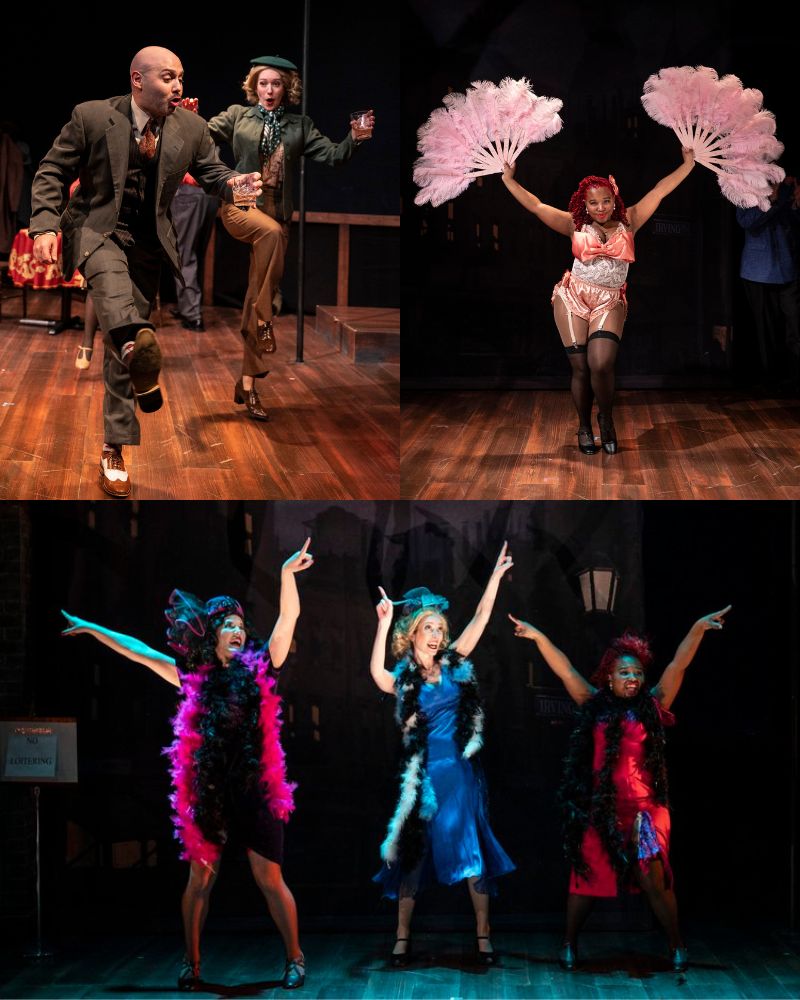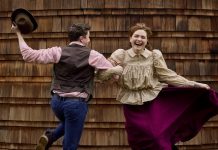The Nance has a lot of sizzle for a show set in the last days of burlesque in late 1930s Manhattan — it just only arrives at unexpected moments.
Historically, burlesque thrived during the Great Depression, especially after many legitimate theaters closed. These weekly shows mixed campy comedy with risqué female performers and drew in large crowds seeking respite from the economically troubled times. The comedy was often so-called Pansy acts, with entertainers playing gay (since being a Nance or a Nancy, a homosexual, was against the law), and the female performers often turned out to be strippers — a daring combination in the 1930s.

The Nance, a Tony-winning play written by Douglas Carter Beane and directed for 1st Stage by Nick Olcott, opens in the iconic Automat in Greenwich Village, a hook-up place (in modern parlance) for gay men. It’s where Chauncey Miles (Michael Russotto), a headlining burlesque performer, meets a newcomer to the big city, Ned (Patrick Joy), who is down on his luck.
While The Nance is often a slow burn, especially the first act, Russotto plays flamboyant and funny fabulously well. The double entendres and the over-the-top mannerisms might make a few of us squirm in the politically correct era that we live in, but that seems to be the point. He also surprises us with the depths of his self-awareness and sacrifice — a powerful mixture. He’s expected to play gay on stage but be straight off stage, and ultimately, he cannot — and he must face the emotional and legal consequences.
Joy, playing a rube, a greenhorn to the city, is the perfect counterpoint of innocence and insight — and physical comedy. The tension in the gay camp moments, moments of winks and caricature, alongside Chauncey and Ned’s heated relationship, a love that cannot be public, ultimately makes the play.
The player that most sizzles, mugs for the audience, and plays his schtick to the hilt is Michael Innocenti as Efram. As a comedian and the burlesque’s producer, this big macha and mensch steals the show. He’s hilarious in his vaudevillian comedy bits (“Slowly, I turned, step-by-step…”) and a bigger-than-life presence when he steps into the role of the harried and hassled producer trying to keep Mayor Fiorella LaGuardia’s morality watchdogs at bay.

I wish the same character nuance and depth were given to the female characters. Played by Day Ajose (Joan), Natalie Cutcher (Sylvie), and Sally Horton Imbriano (Carmen), these female burlesque performers are in roles that do not have the same crackle as the men’s. Their characters feel underwritten. Even so, these actresses go at their burlesque numbers with verve, reaching for the irony of playing burlesque amid a world in crisis. Several of their numbers include classic moves choreographed beautifully by Jennifer Hopkins.
One moment goes farther than others. With a citywide strike pending in response to LaGuardia threatening to close the burlesque houses, Sylvie transforms from her Southern belle act into a platinum blonde spitfire, a card-carrying socialist and unionist, wearing Katherine Hepburn–style trousers. Cutcher plays this dramatic moment to the hilt. Then it’s back to the men. One imagines there’s another play somewhere that centers the women in burlesque in 1930s Manhattan.
The music — led by Music Director Joe Walsh on piano, Dana Gardner (reeds) Anthony Dass (trumpet), Jim Hofmann (drums), and Cyndy Elliott (bass) — popped. The band jazzed the scenes, enveloping the stage in the 1930s, and accentuating the comic and the tragic with just the right notes. It would have been fun for them to have been more of a visible presence playing off the performers like an old-time band leader might have, rather than at the back of the stage.
The costumes by Kendra Rai transported all back with a grand, jazzy array of women’s hats and men’s fedoras, three-piece suits, Japanese kimonos, garters, and seamed nylons. The props by Pauline Lamb also did the trick, especially the old-time hardback suitcases toted by the cast as they left Manhattan for Newark, New Jersey, at the end of the show. It’s 1937, licenses for burlesque shows are denied, and burlesque is out of business in New York City.
The Nance is tragic, it’s funny, it’s a commentary on how far we’ve come — and how we must stay vigilant against the forces that want to turn the clock back.
Running Time: Two hours and 45 minutes plus a 15-minute intermission.
The Nance plays through April 21, https://1ststage.org/events-one/nance52024, at 1st Stage, located at 1524 Spring Hill Road, Tysons, VA. Tickets are $55 for general admission and are available for purchase by calling the box office at 703-854-1856, going online, or in person before each performance. Limited numbers of seats are offered at $25 and $35 for each performance. Open seating.
The program for The Nance is online here.
COVID Safety: 1st Stage is now a mask-optional space with select mask-required performances offered for each show (for The Nance, April 13 at 7:30 pm). See 1st Stage’s complete COVID Safety Information here.




